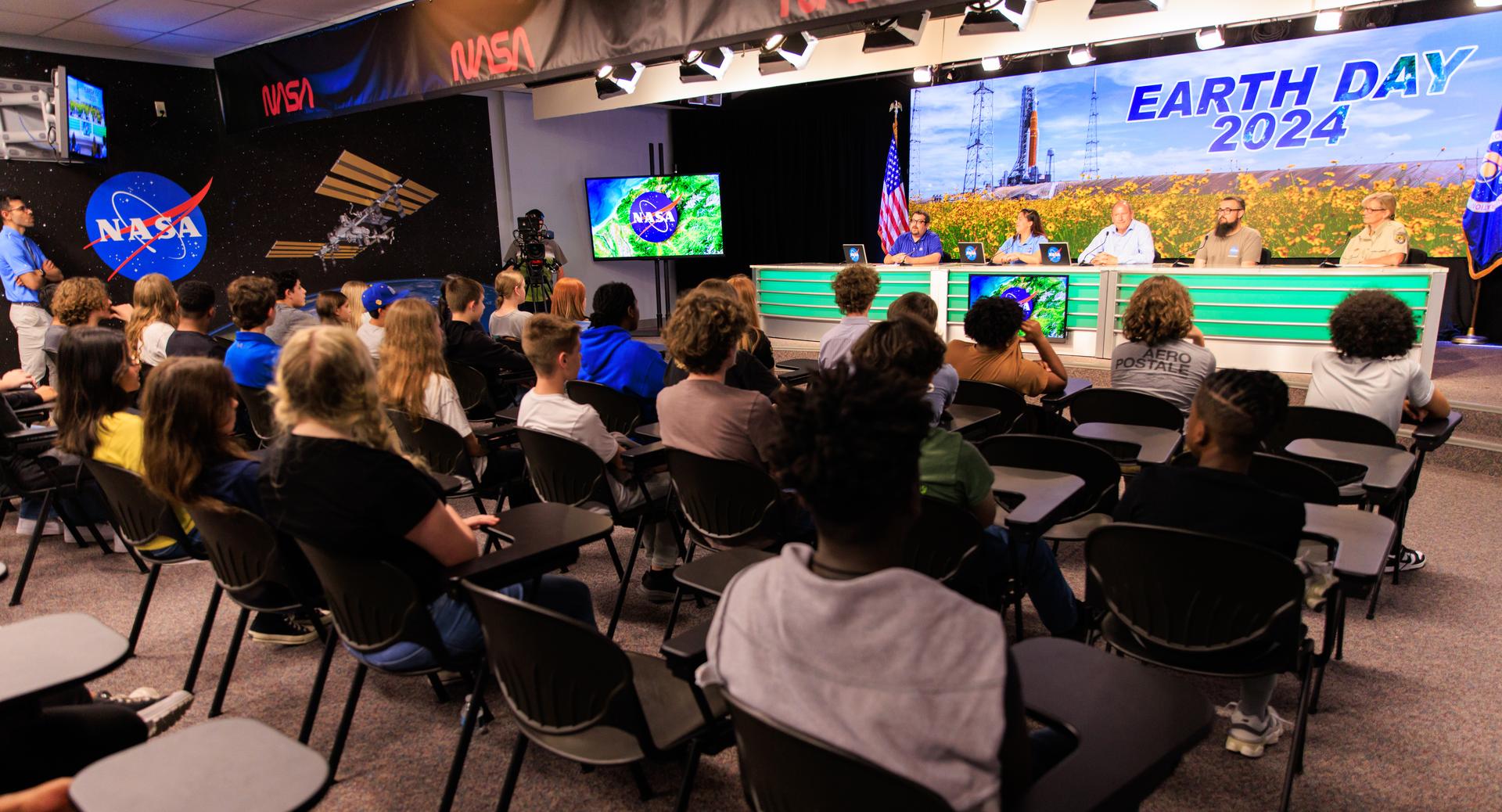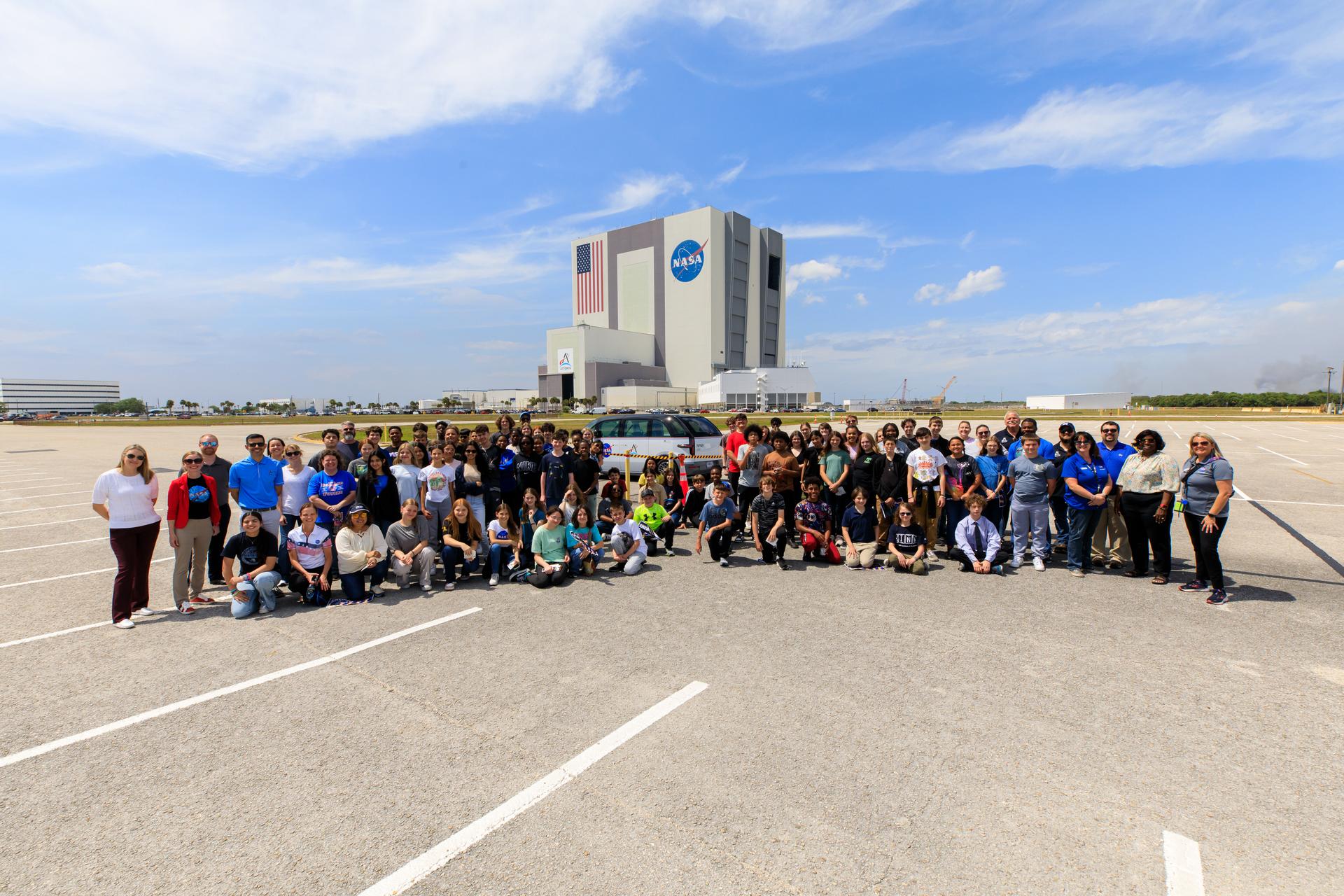
At NASA’s Kennedy Space Center, sustainability and preservation efforts here on Earth are as much of a priority as rocket launches, spacecraft, and the exploration of worlds beyond our own.
In celebration of Earth Day 2024, nearly 100 students from Andrew Jackson Middle School in Titusville, Florida, and a virtual audience of students across the country, attended NASA’s Next Gen STEM Earth Day panel at the NASA News Center’s John Holliman Auditorium and press site “bullpen.”
On hand were NASA environmental and educational experts who discussed Kennedy’s unique role balancing space launch technology and protected habitat, the center’s new electric vehicle charging stations, and NASA’s Earthrise educational initiative that aims to increase science, technology, engineering, and mathematics literacy.
Bob Kline, acting chief of Kennedy’s Environmental Assurance Branch, helped students learn about the importance of protecting the habitat that is refuge to more than 1,500 species of plants and animals. NASA Kennedy shares a boundary with the Merritt Island National Wildlife Refuge and the Canaveral National Seashore, which encompass over 140,000 acres of land, waters, and protected habitats.
“Because we’re a wildlife refuge, it’s easy to think the launches would impact the wildlife, but it’s mostly the buildings that might get impacted by wildlife trying to live on them,” said Kline. “During renovations we’ve had to do special things to protect bats and other birds who live in roofs or under bridges. Everything we do, we’re very mindful of the animals, whether they’re endangered or not. We care about them deeply.”
Panelist Kim King-Wrenn, a park ranger from Merritt Island National Wildlife Refuge, echoed Kline’s message. She told students that the spaceport is one of the most biologically diverse places in the world.
Home to everything from the Florida scrub jay to endangered green sea turtles, King-Wrenn classifies Kennedy as the goldilocks of climate zones.
“Right here is where the northern temperate zone and the southern, subtropical zones come together,” King-Wrenn said. “The more habitat diversity there is, the more diverse homes there are for more kinds of animals.”
Students like 7th grader Zoe Oderman were fascinated by the coexistence of nature and technology across the spaceport. “The Vehicle Assembly Building was awesome, but I love that the beaches at Kennedy Space Center give turtles a place to lay their eggs, because other places in the area don’t,” Oderman said.
Kennedy employee Spencer Davis discussed the installation of 56 electric vehicle charging stations during his time at the NASA Transportation Office on center. The new infrastructure helps support a fleet of electric government vehicles including the all-electric crew transport vehicles that will take Artemis astronauts from their crew quarters to the launch pad.

Later this summer, Davis and his team will be honored at the White House for these efforts to facilitate a future of zero carbon emission government vehicles and help save taxpayer money.
“The big takeaway here is in order to charge up and drive one of Kennedy’s Chevrolet Bolts 100 miles, it only costs $2.80,” Davis said. “That’s basically the price of a soft drink.”
The students also learned about Earthrise from panelist Kelly McCarthy, program specialist with NASA’s Office of STEM Engagement at the agency’s Stennis Space Center in Mississippi.
The NASA education initiative provides educators with access to monthly collections of resources aimed at increasing STEM literacy and understanding the importance of protecting our home planet.
“Earthrise is a really good way to find out the most relevant and useful solutions-based resources that exist right now,” McCarthy said.
Besides offering their expertise on sustainable practices as well as words of encouragement to the future stewards of our planet, the panelists inspired students to pursue STEM careers, including at Kennedy.
“You can do anything you want to do out here, and if you really apply yourself you can get into any field,” Davis told the students. “Don’t be afraid to step outside the box. Don’t be afraid to do something completely different, even if it’s scary. Take every opportunity and seize the moment.”
The event was coordinated through the Next Gen STEM project in NASA’s Office of STEM Engagement, which reaches students in schools and informal classrooms across the county.
View NASA’s Next Gen STEM Earth Day Student Briefing here:
























